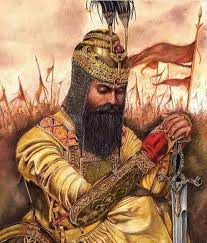Maharaja Ranjit Singh, often hailed as the Lion of Punjab, stands as a towering figure in Indian history, particularly in the context of the Sikh Empire. His reign marked a period of unprecedented unity, prosperity, and military prowess in the region of Punjab. Born on November 13, 1780, in Gujranwala, Ranjit Singh ascended to power at a young age, eventually establishing a formidable empire that stretched across vast swathes of northern India.
Ranjit Singh’s early years were shaped by the turbulent political landscape of Punjab. With the decline of the Mughal Empire and the rise of various Sikh chieftains vying for supremacy, the region was engulfed in chaos and instability. It was amidst this backdrop that Ranjit Singh emerged as a charismatic leader, uniting disparate Sikh factions under his banner and embarking on a mission to consolidate power.
One of the defining characteristics of Ranjit Singh’s rule was his military acumen. Recognizing the importance of a well-trained and disciplined army, he instituted reforms that transformed the Khalsa, the Sikh army, into a formidable fighting force. Under his leadership, the Khalsa employed innovative tactics and weaponry, blending traditional Sikh martial prowess with modern military strategies.
Ranjit Singh’s military campaigns were marked by both conquest and diplomacy. He skillfully navigated the complex web of regional politics, forging alliances with neighboring states while expanding his territorial holdings through a series of strategic maneuvers. Through a combination of military might and diplomatic finesse, he succeeded in bringing vast swathes of Punjab under his control, establishing the foundations of the Sikh Empire.
However, Ranjit Singh’s legacy extends beyond his military exploits. He was also a visionary ruler who implemented progressive administrative reforms aimed at fostering social harmony and economic development within his realm. His commitment to religious tolerance earned him widespread admiration, as he granted autonomy and protection to religious minorities, including Hindus, Muslims, and Christians, fostering an environment of inclusivity and pluralism.
Furthermore, Ranjit Singh’s patronage of the arts and culture contributed to the flourishing of Punjabi literature, music, and architecture during his reign. He commissioned grand architectural projects such as the Lahore Fort and the iconic Harmandir Sahib, popularly known as the Golden Temple, which remain enduring symbols of Sikh heritage to this day.
Despite his many achievements, Ranjit Singh’s reign was not without its challenges. Internal power struggles and external threats from rival empires posed constant obstacles to his ambitions. The British East India Company, in particular, emerged as a formidable adversary, seeking to expand its influence in the Indian subcontinent. Ranjit Singh engaged in a delicate balancing act, maintaining strategic alliances with the British while safeguarding the autonomy of his empire.
Tragically, Maharaja Ranjit Singh’s death in 1839 marked the beginning of the decline of the Sikh Empire. The absence of a strong central leadership paved the way for internal strife and external aggression, ultimately culminating in the annexation of Punjab by the British in 1849 following the Second Anglo-Sikh War.
Nevertheless, Ranjit Singh’s legacy endures as a testament to the resilience and spirit of the Sikh people. His vision of a united and prosperous Punjab continues to inspire generations, serving as a reminder of the rich cultural heritage and indomitable spirit of the region. In commemorating the life and achievements of Maharaja Ranjit Singh, we honor not only a historical figure but also a symbol of courage, leadership, and enduring legacy.






